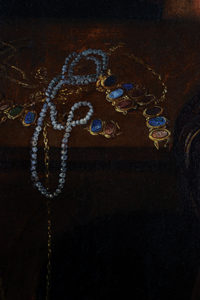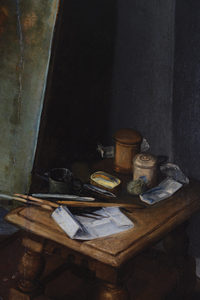Above: Skin, hair and fabric all share a fresh glow in this detail from a valuable artwork that languished in the shadows under centuries of darkened varnish and the grunge of time.
Writer: Vicki L. Ingham
Photographer: Duane Tinkey
A dingy old painting pulled from a gloomy nook is about to experience a bright new life, with a new identity and a new value, enjoying it all from a perch on a wall at Hoyt Sherman Place. In many ways, the painting known as “Apollo and Venus” is a lottery winner in the art world, an instant celebrity plucked from obscurity by chance, destiny or mysterious intervention.
Hoyt Sherman will unveil the restored painting March 21 at a special event (see details, page 146). As you may recall when we introduced the artwork in a previous dsm story, Hoyt Sherman’s executive director, Robert Warren, had been rummaging through a stash of old stuff, looking for Civil War flags, when he spotted some paintings tucked behind a table.
One of them, a large, unsigned, oil-on-wood panel depicting a mythological scene, looked intriguing, he says, “so we pulled it out and put it on the table, thinking we’d go back to it.” Later, a member of the art and archives committee noticed it and texted Warren, saying, “I seem to recall that piece might be valuable.”
As Warren wrapped the painting for protection, he noticed an auction tag on the back, identifying the work by name and attributing it to Italian artist Federico Barocci (1526-1612). The tag also named the owner, N.B. Collins. (See accompanying story, page 145.)
Warren remembered that the Collins family was the one that donated five very valuable paintings to the Des Moines Women’s Club, which had established the art gallery at Hoyt Sherman Place in 1907. One of the five, “To the Memory of Cole” by Frederic Edwin Church, was auctioned by Sotheby’s in 1999 for more than $4 million. (The proceeds helped fund an endowment to preserve Hoyt Sherman Place.)
Above: In this before-and-after comparison, the conservation work is remarkable—not just in brightening and clarifying the figures, but in revealing details seemingly lost in the image prior to the restoration.
Mystery and Intrigue
Unlike the other paintings from the Collins family, “Apollo and Venus” had apparently never been displayed in the Women’s Club gallery. “From the notes, we’re assuming it was put away because it was in bad shape,” says Warren, before positing another more intriguing explanation: “or possibly the content.”
In the painting, Venus and an unexplained cherub appear unfettered by fashions. Not a stitch on them. It is perhaps not coincidental that the Women’s Club collection included nary a nude in the 1920s, when “Venus and Apollo” made its appearance. For whatever reason, the painting remained tucked out of sight—not exactly lost, but not appreciated either.
Stored for decades in an upper-level room with no humidity controls, the wood panel was cracked in places, its paint flaking and dirty, its image dulled by old varnish. Warren shipped the painting to Chicago conservator Barry Bauman, who had conserved most of the other paintings in the Women’s Club collection (53 to that point).
Bauman, a fellow of the American Institute for Conservation, worked at the Art Institute of Chicago for 11 years before leaving as associate conservator of paintings and opening his own conservation practice in 1983. Now he works pro bono for museums and nonprofit organizations. The State Historical Society of Iowa, whose “Dream of Arcadia” he brought heroically back to life, has benefited from his skills, as has the Scholte House Museum in Pella.
Suspicions and Sleuthing
Despite the attribution to Barocci, Bauman thought the painting seemed more Northern European than Italian. He wrote to a longtime colleague, Robert Baldwin, associate professor of art history at Connecticut College. “I said, ‘I sense there’s a Flemish side to this painting; it looks pre-Rubenesque somehow,’ ” Bauman recalls.
Bauman credits Baldwin with the suggestion of Otto van Veen (1556-1629), a Dutch-born painter now best known as a teacher and friend of Peter Paul Rubens, the Baroque era’s most important painter.
After researching and conserving the painting, Bauman found confirmation of van Veen’s authorship through consultation with national and international scholars. Although the work is undated, he estimates it was painted around 1600, which would make it the oldest Old Master painting in a public collection in Des Moines.
Successful and respected in his own day, van Veen today is considered “a second-level artist,” Baldwin says. “His style is sweet, delicate and highly dramatic, with some of the twisting, serpentine bodies of late 16th-century Mannerism.”
What interests Baldwin about “Apollo and Venus” is its allegorical treatment of a key Renaissance theme, the nobility of painting, music and poetry as divine pursuits. The painting is based loosely on an engraving by an Italian artist, he says, indicating the continuing importance of Italian sources and ideas for Northern European artists. Depicting Venus as the goddess of painting alongside Apollo, god of poetry and music, asserted the equal status of the three arts, an idea introduced during the Renaissance.
(Before that time, painters and sculptors were viewed as lowly craftsmen and manual laborers, while music and poetry were considered high-minded, intellectual endeavors.)
“Van Veen also played on the Italian Renaissance idea that the closest image of the divine in the earthly sphere was the human body,” Baldwin says, “which led the soul upward toward divine beauty. If Italian Renaissance aesthetics established human beauty as an essential, even exemplary, subject of art (for example, in Michelangelo and Titian), the beauty of Venus in particular allowed artists and writers to tie artistic beauty to platonic love and the ascent of the human soul from earthly to celestial love.”
‘Critical Condition’
The painting that reached Bauman’s studio was anything but divine, however. In fact, it was in critical condition. The conservator’s first task was to stabilize the paint layer. Working under a binocular microscope, he secured the lifting paint back into position, using either a small brush or a dental tool and liquid adhesive. Then, still under the microscope, he removed the discolored varnish, using cotton swabs and a solvent that swells and removes the varnish without damaging the original paint layer.
“At the same time,” he says, “I had to remove all the former restoration work that had been done on the painting,” a delicate operation in itself.
Once the old varnish and the effects of previous restoration attempts were removed, Bauman carefully filled in the areas of missing paint with gesso to bring the areas of paint loss up to the same plane as the surviving paint. Before “inpainting” to restore those areas with acrylic paints formulated specifically for conservators, he applied a non-yellowing varnish.
The varnish serves as “an ethical buffer between the original layer and the infill painting that I do, so all of my work is reversible,” Bauman explains. “Everything in conservation has to be reversible.” If future conservation is needed, his inpainting and the varnish come off with a weak solvent, doing no harm to the original painting.
Back Home
Bringing “Apollo and Venus” back to its original glory completes Hoyt Sherman’s project of revitalizing its main art galleries, which has helped put the mansion on the map as a tourist destination.
“We do tours now, we have written several grade-level-based study guides for teachers, and we just hired a collections management associate who has been at the Smithsonian for years,” Warren says, “so we’re ramping up all of that as quickly as we can.
“I’m curious to see what kind of response we get when [‘Apollo and Venus’ is] out there in the public,” Warren adds.
“Otto van Veen doesn’t come into the public eye every day.”

The Collins Family
Chicago conservator Barry Bauman’s detective work in discovering the identity of the artist who created “Apollo and Venus” also turned up the fact that the Collins family in 1881 had loaned the painting and two others, “The Repentant Magdalene” and “Lot and His Daughters,” to the Metropolitan Museum of Art. “Apollo and Venus” remained on display there until 1884.
How and when Nason Benjamin Collins and his wife, Sarah Louisa Scofield Collins, acquired the paintings is unknown. Born in New York in 1834, Nason Collins was the son of a well-known steamship captain. He married Sarah in 1855 and worked as a merchant buying and selling grain and flour. During the Civil War he served as an officer in the New York National Guard and worked with the Sanitary Commission, caring for soldiers wounded in the war.
Collins also threw himself into philanthropy and charitable work. According to his obituary in the Iowa State Register, he helped organize the Artists’ Aid Society in New York and served as its treasurer. Still functioning today as the Artists’ Fellowship, the organization supports artists’ families in times of illness or bereavement. He also headed several mission schools and helped organize Sunday schools and hospitals.
In 1871, at age 37, Collins brought his wife, their four children and his widowed mother to Des Moines, where he dealt in lumber, then wholesale groceries, and finally farming. He also continued his charitable and civic work and was active at Central Presbyterian Church until his unexpected death from pneumonia in 1894.
His wife died in 1901, apparently leaving their art collection to their only daughter, Elizabeth Nason Collins Coskery (1865-1938). Coskery’s daughter, Margaret Louise Coskery, loaned the five paintings to the Des Moines Women’s Club in 1922-1923. She conveyed them as a gift in 1952, enriching the club—and the city—more generously than she or her family could have imagined.

The tools of the painter’s art, assembled to the right of Venus.
Otto van Veen
Otto van Veen was born in the Netherlands and studied in Belgium with the humanist poet and painter Dominicus Lampsonius. Robert Baldwin, associate professor of art history at Connecticut College, notes that like most ambitious Northern European artists, van Veen then spent about five years in Rome, absorbing the lessons of the Italian Renaissance—mastery of perspective, proportion, anatomy and composition, as well as philosophy, poetry, music, mythology and classical history.
Commissions from the royal courts in Prague, Munich and Brussels established van Veen’s credentials as both a scholar and a master painter. In 1593 he moved to Antwerp and opened a studio and workshop, where he and his apprentices (including Peter Paul Rubens) took on commissions for churches, government buildings and royal patrons.
In addition to producing portraits and paintings on historical, religious and allegorical topics, van Veen was known for his emblem books, a literary genre that was popular in 17th-century Europe. Combining engravings of allegorical images with short mottoes, verses or text, the books appealed to an affluent, educated audience.
Van Veen’s “Amorum emblemata” (1608) has been described by scholar Tina Montone as “one of the most influential books of its time, functioning not only as a model for other Dutch and foreign emblem books, but also as a source of inspiration for many artists in other fields.”
Unveiling and Presentation
The newly framed “Apollo and Venus” will be unveiled at a special presentation at Hoyt Sherman Place on March 21. The theater, mansion and gallery will open at 5 p.m. for self-guided tours, with the presentation at 6 p.m. in the theater. A reception will follow the presentation. Admission is free.













